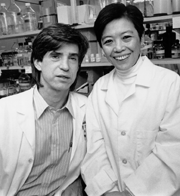
The newly discovered pathology--a plaque-like lesion involving a previously unidentified protein--appears to constitute as much as a quarter to a third of the volume of affected gray matter tissue in Alzheimer's disease brains. Additionally, it is rare or absent in other neuro-degenerative diseases. As such, it represents an important new clue concerning the origins and course of Alzheimer's disease and a likely target for therapeutic interventions to slow or halt this baffling and devastating disease.
"This is a spectacular lesion, never before seen, that tracks closely with the disease state--more specifically than tangles and perhaps more specifically than amyloid plaques," said Dr. John Q. Trojanowski, the professor of pathology and laboratory medicine and director of the Alzheimer's Disease Center at Penn who is senior author on the study report, which appears in the July issue of the American Journal of Pathology. "It occupies as much of the Alz-heimer's brain as amyloid plaques do. As a result, we have every reason to suspect that this pathology will be found to play a crucial role in the development and progression of Alzheimer's disease."
"I find this discovery very exciting because it introduces a new element into the study of this complex disease process," adds Dr. Marcelle Morrison -Bogorad, associate director of the Neuroscience and Neuropsychology of Aging program at the National Institute on Aging. "These plaque-like structures have never before been identified in Alzheimer's brains. The new and mysterious protein found in these structures may prove very useful in future research endeavors into the causes and evolution of a dreadful disease."
Dr. Zaven Khachaturian, director of the Alzheimer's Association Ronald and Nancy Reagan Research Institute also called it a significant finding. "If confirmed, this may become a central issue in our understanding of Alzheimer's disease," he said. "This discovery may open fresh avenues for investigating the cause or causes of Alzheimer's, give us a new diagnostic marker, and provide new targets for treatments."
A question likely to be asked is how such a pervasive pathology in an intensely studied disease could go undetected for so many years.
"The staining and chemical dye methods that have been used in the past to label Alzheimer's disease pathologies--primarily silver and thioflavin staining--do not pick up this lesion," notes Dr. Virginia M.-Y. Lee, a professor of pathology and laboratory medicine who collaborated closely on the research and is co-author of the article. "A new series of antibodies we created to explore elements of the neurofibrillary tangles, however, did."
Drs. Trojanowski, Lee, and colleagues generated four monoclonal antibodies from immunogens found in the tangles, hoping to be able to use the antibodies to tag and learn more about the proteins that make up those structures. To their surprise, the antibodies did not recognize proteins in their intended targets but, instead, revealed the extensive new lesion. Further analysis with one of the four antibodies--called AMY117--showed the plaque -like structures to consist of a novel protein with a molecular weight of 100 kilodaltons that never colocalized with the previously known amyloid plaques.
In current experiments, the researchers are hoping to be able to clone and sequence the gene that codes for the new protein. The lead author on the study is Dr. Marie Luise Schmidt, senior research investigator, and other co-authors are Dr. Mark Forman of HUP and Ting-Shan Chiu of the technical staff. Funding support was provided by the National Institute on Aging.
-- From a news release by Franklin Hoke
Photo of Drs. John Trojanowski and Virginia Lee by Tommy Leonardi
Almanac
Volume 44 Number 1
July 15, 1997
Return to Almanac's homepage.
Return to index for this issue.